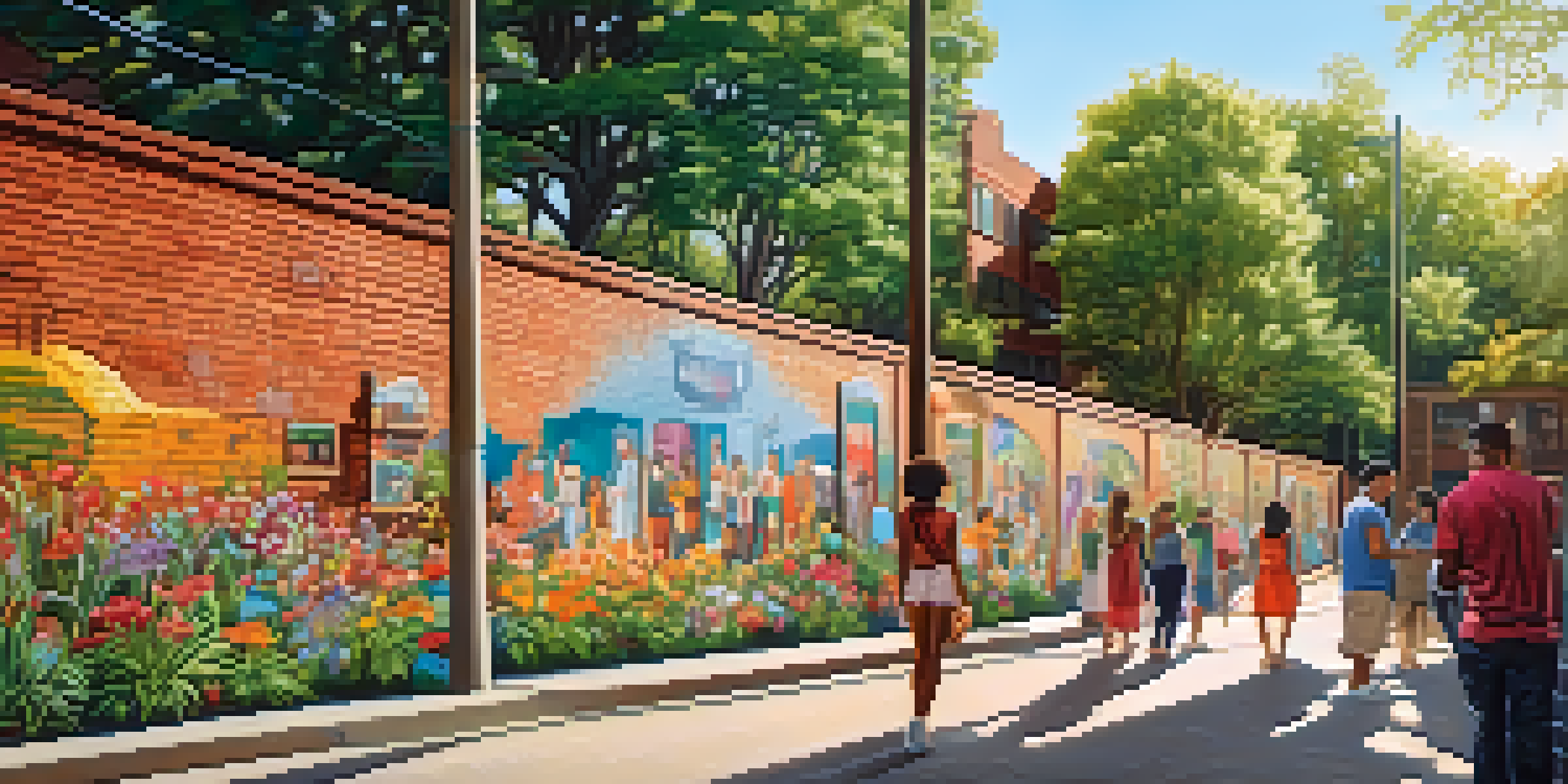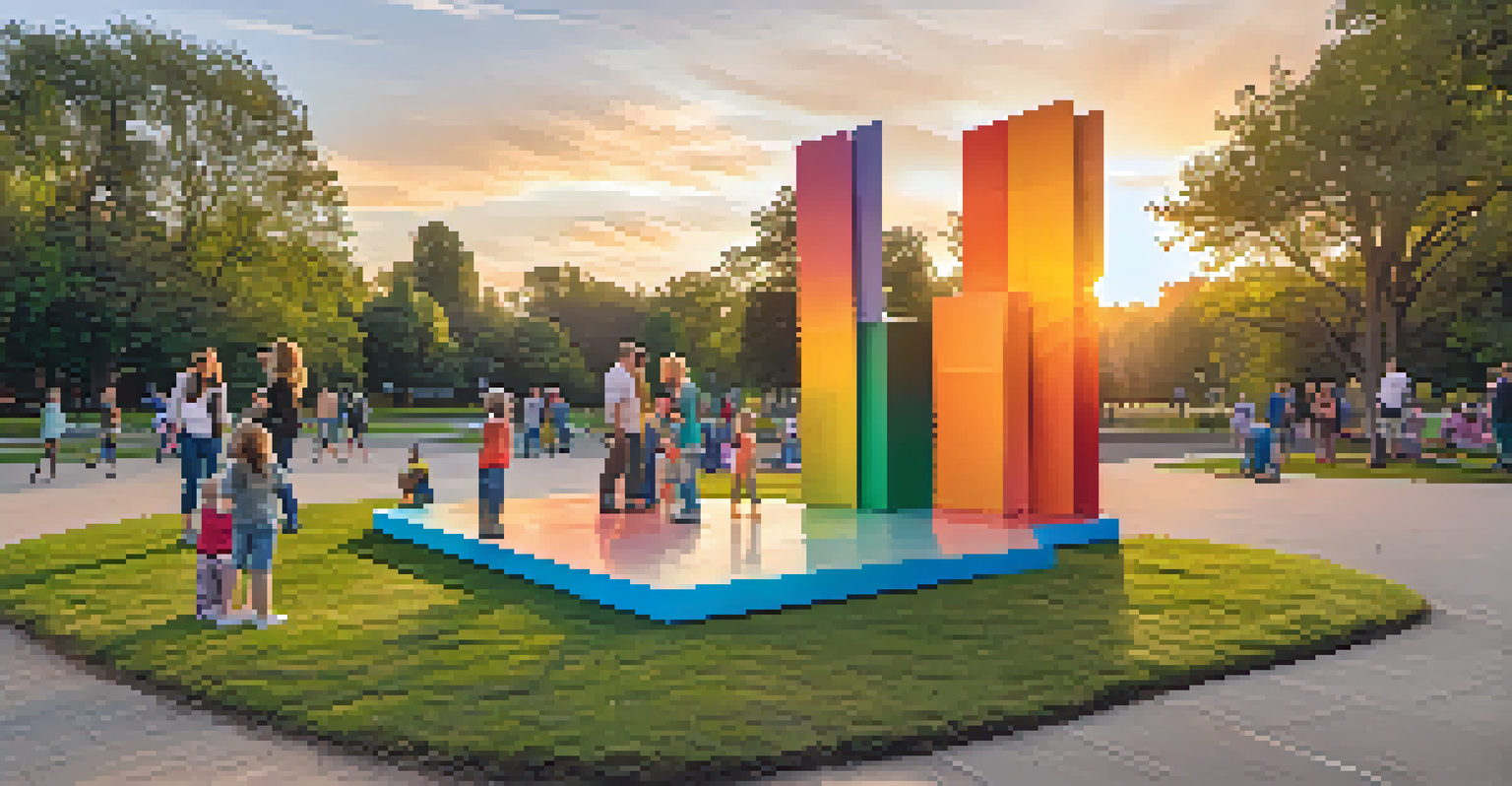Art in Public Spaces: A Global Perspective on Urban Culture

Understanding the Role of Art in Public Spaces
Art in public spaces serves as a mirror, reflecting the unique identity of urban areas. It transforms mundane environments into vibrant cultural hubs, encouraging community interaction. By showcasing local artists and their work, cities can celebrate diversity and foster a sense of belonging among residents.
Art is not what you see, but what you make others see.
Consider the murals in neighborhoods like Wynwood in Miami, where colorful street art attracts tourists and locals alike. These visual expressions tell stories of the community’s history and struggles, making art a powerful means of communication. This transformation not only beautifies the space but also instills pride and ownership among the community members.
Ultimately, public art invites dialogue and reflection. It becomes a canvas for social issues, sparking conversations about race, gender, and environmental concerns. By integrating art into urban design, cities can create dynamic spaces that resonate with their inhabitants.
The Impact of Public Art on Urban Communities
Public art initiatives can significantly enhance the quality of life within urban communities. They provide a platform for artists to express their creativity while engaging residents in meaningful ways. From sculptures in parks to interactive installations, art invites participation and interaction.

For example, the 'Before I Die' wall project, which has spread globally, encourages community members to share their aspirations and dreams publicly. This simple act fosters connections among people, creating a sense of unity and shared experience. Such initiatives not only beautify neighborhoods but also empower residents to share their voices.
Art Transforms Urban Spaces
Public art enhances the identity of urban areas, fostering community interaction and pride.
Moreover, public art can stimulate local economies by attracting tourists and generating interest in the area. As people visit to see these artistic installations, local businesses often benefit from increased foot traffic. This symbiotic relationship enhances community pride and further solidifies the importance of art in urban spaces.
Cultural Diversity Reflected in Urban Art
Urban art often showcases the cultural diversity present in cities around the world. Each piece tells a story that encapsulates the heritage, struggles, and aspirations of different communities. This rich tapestry of artistic expression fosters understanding and appreciation among diverse populations.
Public art is about engaging people in the process of discovery and creating a sense of place.
Take for instance the vibrant street art in Berlin, which reflects the city’s tumultuous past and its journey toward unity and diversity. Artists from various backgrounds contribute to this evolving narrative, making the city a living gallery of cultural expression. This artistic dialogue not only preserves history but also embraces the future.
The presence of multicultural art in urban spaces serves as a reminder of the importance of inclusivity. It encourages conversations about identity, belonging, and representation. By celebrating diverse artistic perspectives, cities can cultivate a more cohesive and harmonious community.
Challenges Faced in Public Art Projects
While public art has many benefits, it also faces several challenges that can hinder its development. Issues such as funding, bureaucratic red tape, and community opposition can create obstacles for artists and organizations. Navigating these challenges requires creativity and collaboration among stakeholders.
For example, securing funding for public art projects can be daunting, especially in economically strained cities. Artists often rely on grants, sponsorships, and community fundraising to bring their visions to life. However, when communities rally behind a project, it can become a catalyst for change and revitalization.
Public Art Boosts Local Economies
Art initiatives can attract tourists, generating increased foot traffic that benefits local businesses.
Additionally, some residents may feel conflicted about the type of art presented in their neighborhoods. Engaging the community in the planning process is vital to ensure that the art reflects their values and aspirations. By addressing concerns and fostering dialogue, cities can create public art that resonates with everyone.
Case Studies of Successful Public Art Initiatives
Examining successful public art initiatives can provide valuable insights into effective practices. Cities like Melbourne and São Paulo have implemented innovative programs that engage communities and enhance urban life. These case studies highlight the potential of art to transform spaces and foster connections.
In Melbourne, the laneways are famous for their ever-changing street art, attracting both tourists and locals. This initiative not only beautifies the area but also supports local artists and businesses. By allowing artists to take creative risks, the city has cultivated an environment where art thrives.
Similarly, São Paulo's 'City of Art' program encourages community participation in the creation of murals and installations. The project has revitalized neglected areas, turning them into vibrant galleries. These examples demonstrate how investing in public art can yield significant social and economic benefits.
The Future of Public Art in Urban Environments
As cities continue to evolve, the future of public art looks promising yet challenging. Technological advancements, such as augmented reality, are opening new avenues for creative expression. Artists are now able to engage audiences in immersive experiences that transcend traditional art forms.
Moreover, there is a growing emphasis on sustainability in public art projects. Artists are increasingly using recycled materials and eco-friendly practices to create installations that raise awareness about environmental issues. This shift not only enhances the aesthetic appeal but also aligns with global sustainability goals.
Diversity Celebrated Through Art
Urban art reflects cultural diversity, promoting conversations about identity and inclusivity among communities.
Ultimately, the future of public art will be defined by collaboration and inclusivity. As urban populations become more diverse, art must reflect these changing dynamics. By embracing innovation and community engagement, cities can ensure that public art remains a vital component of urban culture.
Conclusion: Celebrating Art as a Reflection of Urban Life
In conclusion, art in public spaces is a powerful tool for shaping urban culture and fostering community connections. It reflects the diversity, struggles, and aspirations of city dwellers, creating a narrative that enriches the urban experience. By investing in public art initiatives, cities can enhance their identity and promote social cohesion.
As we've explored, the benefits of public art extend beyond aesthetic appeal; they encompass economic, social, and cultural dimensions. Engaging communities in the creation and appreciation of art fosters a sense of ownership and pride in one’s surroundings. This connection ultimately leads to a more vibrant and resilient urban environment.

As we look to the future, it’s essential to continue championing public art as a means to celebrate and reflect the dynamic nature of urban life. By doing so, we not only enrich our cities but also create spaces that inspire and connect us all.